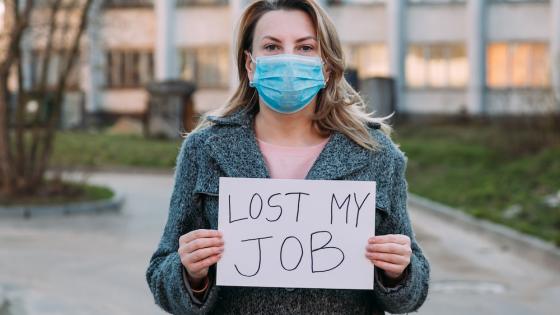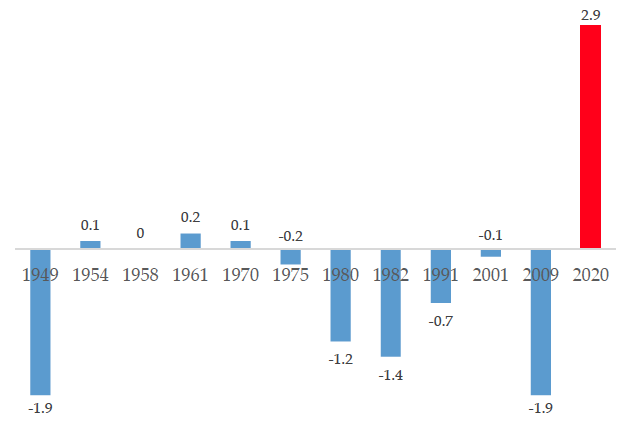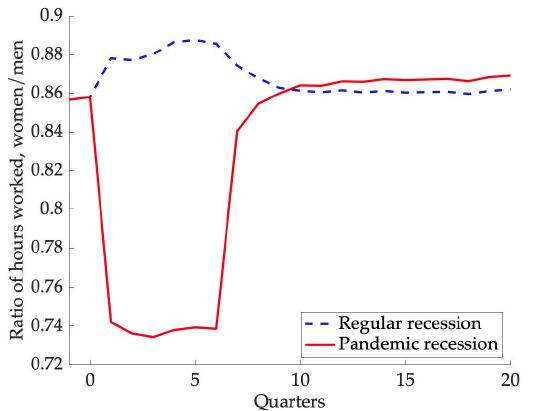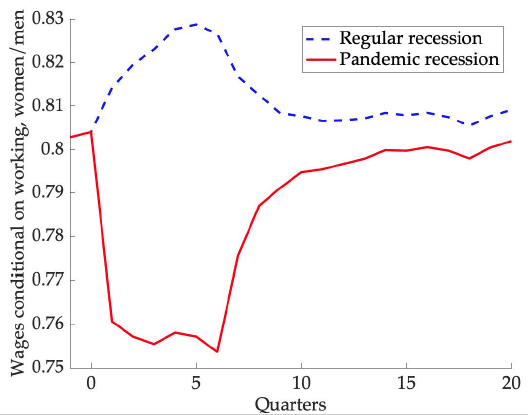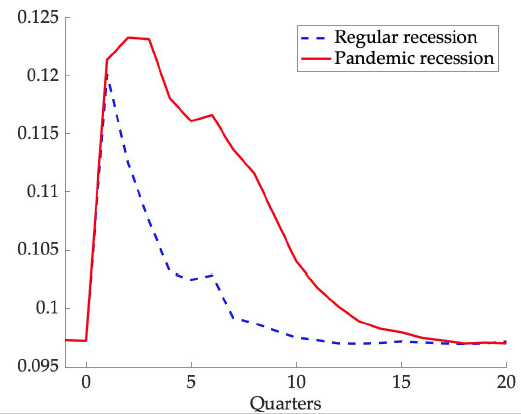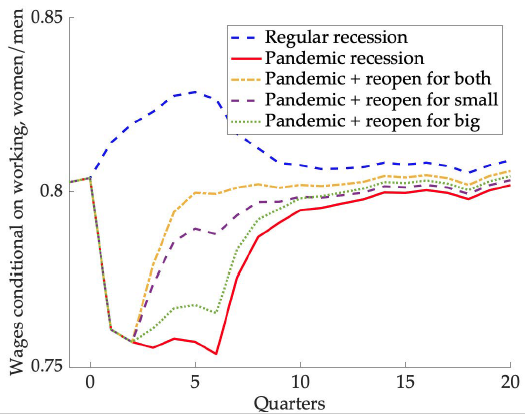Not too long ago, the term ‘mancession’ gained currency to describe the disproportionate impact of recent recessions on men’s employment (Johnson 2009, Wall 2009). In the Great Recession of 2007-2009, millions of men in sectors such as construction and manufacturing lost their jobs, while women experienced much smaller employment losses. Mancessions became the norm starting in the 1970s, a time when women’s labour force participation was sharply increasing and many women found employment in relatively stable sectors such as education, healthcare, and other parts of the service economy (Goodman et al. 1993).
In 2020, as a consequence of the Covid-19 pandemic, the US economy has entered the sharpest economic downturn since the Great Depression. This recession is qualitatively different from other recessions not just in its cause, but also in the patterns of its labour market impact. Arguably, the sharpest deviation from the historical norm is the impact of the recession on the employment of women versus men.
The disproportionate impact of a pandemic recession on working women
Figure 1 shows the difference between the increase in women’s and men’s unemployment in all US recessions since 1949. Before 2020, all recessions were either mancessions or depressed women’s and men’s employment roughly equally. In contrast, in the 2020 recession, job losses are much higher for women. At its peak, women’s unemployment had risen by 2.9 percentage points more than men’s unemployment. This gap is much larger in absolute terms than what was observed (with opposite signs) in recent mancessions.
Figure 1 Difference between rise in women’s and men’s unemployment, US recessions from 1948 to 2020
Source: author’s calculations based on data from the Bureau of Labor Statistics
What’s more, the partial recovery in employment in recent months benefited men more than women. Bick and Blandin (2020) report that in August 2020, women’s labour supply was still 20% below pre-recession levels of February 2020, whereas men’s labour supply was only 9% lower. No previous recession has affected one gender so much more than the other.
There are two primary causes of the disproportionate impact of the current recession on women’s employment. First, women’s employment is concentrated in sectors that are relatively stable in typical business cycles but were strongly affected by the shutdown and social distancing measures during the pandemic. Primary examples are ‘contact-intensive’ sectors such as restaurants, which often have a high share of female employment (Mongey et al. 2020, Albanesi et al. 2020). Second, as schools and daycare centres were shut down, parents’ childcare needs multiplied. Women have provided the majority of additional childcare during the crisis, leaving many of them unable to work (Adams-Prassl et al. 2020, Alon et al. 2020a, Collins et al. 2020).
Consequences of the shecession: Gender inequality
The large impact of the current recession on working women has consequences that will long outlast the recession itself. Most directly, the recession will affect the future earnings opportunities of women who are now unable to work. Evidence from earlier recessions shows that workers who lose employment during a recession experience highly persistent earnings losses (Davis and von Wachter 2011). Finding a new job is difficult; finding one with the same responsibility, pay, and career opportunity as the job that was lost is even harder.
Given that women have lost many more jobs than men in this recession, earnings losses will push down the average earnings of women in the economy and raise the gender pay gap. In our research (Alon et al. 2020b), we quantify the macroeconomic impact of the Covid-19 recession using a macroeconomic model that distinguishes between women and men, married couples and singles, and those with and without children. We further distinguish whether jobs are tele-commutable or not, assuming that jobs that can be done from home are easier to combine with childcare. The division of childcare is decided jointly by married couples based on relative wages in the family, the ability to telecommute, and, for some couples, a social norm that penalises households if the father provides more childcare than the mother.
We calibrate the model to match evidence on skill loss during unemployment, the division of childcare in couples, the gender wage gap, the labour supply of married women, and labour market flows in normal times. We use the model to compare the repercussions of a regular recession and a ‘pandemic’ recession, where the pandemic recession is characterised by relatively higher job losses for women and a large increase in childcare needs.
Figure 2 Ratio of women’s to men’s labour supply in regular and pandemic recessions in a macroeconomic model
As Figure 2 shows, the model for the impact of regular versus pandemic recessions on women and men matches the evidence. A regular recession is a ‘mancession’, meaning that women’s total labour supply increases relative to men’s, whereas the pandemic recession is a ‘shecession’, with deep employment losses for women.
Figure 3 shows what this implies for the gender pay gap. In a regular recession, men lose more jobs, which reduces their labour-market experience and wages. As a consequence, women’s relative human capital increases, which reduces the gender pay gap. In contrast, in the pandemic recession women’s relative wages fall sharply, and stay depressed throughout the recovery. Even years after the end of a pandemic recession, the gender pay gap is more than a percentage point higher compared to the aftermath of a regular recession. The loss in women’s human capital is fully made up only decades later.
Figure 3 Women close the wage gap with men in regular recessions, but fall further behind in a pandemic recession
Consequences of the shecession: Propagation
Beyond gender inequality, the large impact of the current recession is also likely to lead to a deeper and more persistent recession. The depth of a recession depends on the size of the initial shock and on how this shock is propagated within the economy. Propagation, in turn, depends on how strongly income shocks to households are translated into lower consumption demand. If the initial shock leads to a large drop in consumption, additional sectors of the economy see a fall in demand for their products, so that the initial shock is amplified and propagated throughout the economy.
The transmission of income shocks into consumption can be quantified using the marginal propensity to consume (MPC). If MPCs are high, a given reduction in income leads to a large reduction in consumption demand, and shocks are propagated throughout the economy (Guerrieri et al. 2020). We find that a pandemic recession leads to a substantial and persistent increase in MPCs, which has the potential to deepen the recession and hinder the recovery.
A key reason for this result is the impact that a decline in women’s employment has on insurance within the family. In regular recessions, women’s labour supply works as a ‘shock absorber’ in many families – if a husband loses a job, his wife is often able to continue working or even increase her labour supply, which stabilises family income in a recession. This insurance mechanism helps families compensate for income losses and leads to a lower transmission from income to consumption (Bardóczy 2020).
We find that in a pandemic recession, the scope for insurance within the family is much reduced. Many women who otherwise would provide this insurance also lost their jobs. Families with children have little flexibility to react to shocks, because so much of their time is taken up by childcare needs. Figure 4 shows that this results in a higher MPC in a pandemic compared to a regular recession. Moreover, the rise in MPC is much more persistent.
Figure 4 Couples’ marginal propensity to consume (fraction of an additional dollar of income that would be consumed rather than saved) in regular versus pandemic recessions
These findings underline that the large employment losses for women matter for the basic macroeconomic anatomy of a pandemic recession, and provide further evidence in support of recent research arguing that the evolution of women’s labour supply is a crucial determinant of macroeconomic outcomes in advanced economies (Doepke and Tertilt 2016, Fukui et al. 2019, Albanesi 2020).
Policy implications: Effect of school openings
The distinct nature of a pandemic recession also leads to distinct policy implications. Perhaps the most obvious is that opening schools and daycare centres can play a huge role in aiding the recovery. Opening schools would free up a lot of labour supply and immediately increase output. This change would benefit women disproportionately, to the extent that much of the negative impact on women’s relative labour-market experience and relative wages could still be avoided (Figure 5). The figure also shows that sending young kids back to daycare centres does the most for reducing the gender wage gap. However, this result is primarily driven by a compositional effect with high-skill women more likely to return to work. In terms of mitigating the widening gender skill gap, we find that opening schools for older children is more important than opening daycare centres (not shown) because there are many more working mothers with older children and more of them work full time.
Figure 5 The effect of opening schools (for all children, only for younger children in pre-K, or for older children in K-12) on the gender wage gap
Of course, whether schools can be opened depends on whether the pandemic is sufficiently controlled to do so safely. Opening schools is not helpful if it leads to an accelerated pandemic, which, in addition to the impact on health and mortality, might require new shutdown restrictions in the future.
However, the large impact of school openings can help inform the proper trade-off when opening different sectors of the economy. For example, opening a smaller sector of the economy (say, bars and sports venues) would be a bad idea if the resulting rise in infections makes it impossible to open schools later, which renders many parents unable to work, increases the gender gap, and also has a sizeable impact on the education of children and future inequality (Fuchs-Schündeln et al. 2020).
References
Adams-Prassl, A, T Boneva, M Golin and C Rauh (2020), “Inequality in the Impact of the Coronavirus Shock: Evidence from Real Time Surveys”, CEPR Discussion Paper 14665.
Albanesi, S (2020), “Changing Business Cycles: The Role of Women’s Employment”, NBER Working Paper 25655.
Albanesi, S, R Gihleb, J Huo and J Kim (2020), “Household Insurance and The Macroeconomic Impact of the Novel Coronavirus”, Unpublished Manuscript, University of Pittsburgh.
Alon, T, M Doepke, J Olmstead-Rumsey and M Tertilt (2020a), “The Impact of COVID-19 on Gender Equality”, Covid Economics: Vetted and Real-Time Papers 4: 62-85.
Alon, T, M Doepke, J Olmstead-Rumsey and M Tertilt (2020b), “This Time It’s Different: The Role of Women’s Employment in a Pandemic Recession”, CEPR Discussion Paper 15149.
Bardóczy, B (2020), “Spousal Insurance and the Amplification of Business Cycles”, Unpublished Manuscript, Northwestern University.
Bick, A and A Blandin (2020), “Real-Time Labor Market Estimates During the 2020 Coronavirus Outbreak”, Unpublished Manuscript, Arizona State University (version of 4 September 2020).
Collins, C, L C Landivar, L Ruppanner and W J Scarborough (2020), “COVID-19 and the Gender Gap in Work Hours”, Gender, Work, and Organization, forthcoming.
Davis, S and T von Wachter (2011), “Recessions and the costs of job loss”, Brookings Papers on Economic Activity 2: 1–72.
Doepke, M and M Tertilt (2016), “Families in Macroeconomics”, Handbook of Macroeconomics, Vol. 2, North Holland.
Fuchs-Schündeln, N, D Krueger, A Ludwig and I Popova (2020), “The Long-term Distributional and Welfare Effects of Covid-19 School Closures”, NBER Working Paper 27773.
Fukui, M, E Nakamura and J Steinsson (2019), “Women, Wealth Effects, and Slow Recoveries”, Unpublished Manuscript, University of Berkeley.
Goodman, W, S Antczak and L Freeman (1993), "Women and Jobs in Recessions: 1969-92", Monthly Labor Review 116(7): 26-35.
Guerrieri, V, G Lorenzoni, L Straub and I Werning (2020), “Macroeconomic Implications of COVID-19: Can Negative Supply Shocks Cause Demand Shortages?”, NBER Working Paper 26918.
Johnson, D (2009), “It's Not Just a Recession. It's a Mancession!”, The Atlantic, 9 July 9.
Mongey, S, L Pilossoph and A Weinberg (2020), “Which Workers Bear the Burden of Social Distancing Policies?”, NBER Working Paper 27085.
Wall, H J (2009), “The ‘Man-Cession’ of 2008-2009: It's Big, but It's Not Great”, The Regional Economist, Federal Reserve Bank of St. Louis.
